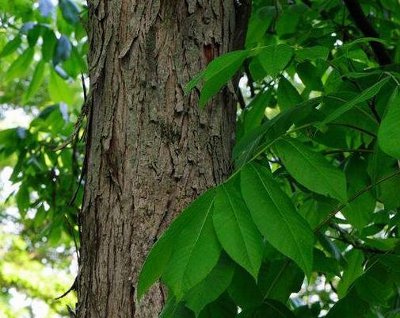Shellbark Hickory Tree
Category: Deciduous Trees

Facts about Shellbark Hickory Tree, "Scientific name for Shellbark Hickory Tree is Carya laciniosa". Shellbark Hickory Tree is a long-lived nut tree, which is the native of wet bottomlands and torrent plains of the United States. This tree is inflexible to transplant due to its extended taproot, and subject to pest damage. The Shellbark Hickory Tree is a strong tree with hairy bark, and is extensively distributed, but is nowhere universal. The tree will offer nuts once in a year within 10 to 12 years of its growth. The Shellbark Hickory tree is a sluggish growing tree and grows well in full sun. The tree grows well in a variety of soils, such as alkaline, acidic, drought tolerant, moist, loamy, rich, sandy, clay soils, etc. When the tree is fully grown, it attains the oval, circular shape.
Features of Shellbark Hickory Tree
The sluggish-growing Shellbark Hickory tree is capable of growing to a height that ranges from 60 feet to 80 feet (18.28 to 24.38 meters), with widespread branches that spread to a maximum of 40 feet (12.19 meters). It is a striking, elevated-branching tree, with a straight, slim trunk and a thin, oblong at the top. The leaves of the tree are pinnately compound, with 5 to 9 leaflets. The length of the leaves of the tree ranges from 10 inches to 24 inches (25.4 to 61 cm). These leaves are dark yellow in color, with green color at the top.
The Shellbark Hickory tree produces flowers during the spring season and they are seen with green color. The oval-shaped fruits of the tree are large in size, covered with a tough, light brown-colored shell of ¼ inches (.6 cm) thick and a length, ranging from 1 3/4 inches to 2 1/2 inches (4.4 to 6.3 cm).
A Full grown Shellbark Hickory Tree can absorb as much as 48 pounds (21.77 kg) of carbon dioxide a year. The same tree could also produce enough oxygen in a day for two people. In a single day, a large Shellbark Hickory Tree can drink up to 100 gallons (378.5 liter) of water from the ground and discharge it into the air.
You can tell a Shellbark Hickory Trees age by the number of growth rings. Growth rings size shows what kind of conditions accrued that year, the temperature and if it was a dry or wet year.
Bark of the Shellbark Hickory Tree protects it from the elements and is made up of dead cells.
Shellbark Hickory Tree roots usually grow two to three times the width of the tree branches. The ideal time to fertilize your Shellbark Hickory Tree is in late fall or early spring. If you want to transplant a tree do it in fall, this is ideal for most trees.
Uses of Shellbark Hickory Tree
The wood of the Shellbark Hickory tree is tough, heavy, strong and extremely flexible, and is used for furniture, sporting goods, tool handles, fuel, veneer and charcoal. The nut of the tree is renowned for its sweetness and is a favorite food for quail, ducks, wild turkeys, chipmunks, squirrels, deer, raccoons, foxes and white-footed mice.
Shellbark Hickory Tree leaves are made up of many colored pigments, green chlorophyll hides the colors during the growing season of spring and summer. As days get shorter and cooler temperatures come in the fall, it cause the chlorophyll to break down and than the other color pigments can be seen.
Shellbark Hickory Tree growth is referred to as Meristem (The undifferentiated embryonic plant tissue from which new cells are created, as that at the tip of a root or stem). This tissue can be found at the tips of shoots and leaves. Inside the stem growth in thickness occurs at the vascular cambium.
Shellbark Hickory Trees make their own food from sunlight, carbon dioxide, water, and nutrients from the soil.
The average lifespan of the Shellbark Hickory tree can be more than 80 years.

 Back To Category Deciduous Trees
Back To Category Deciduous Trees